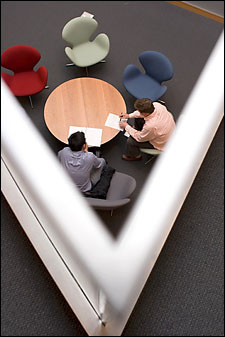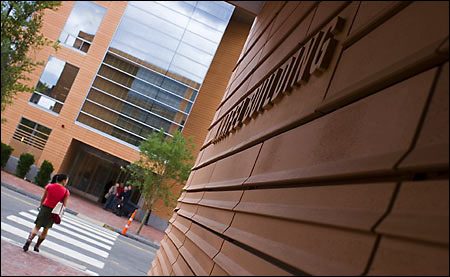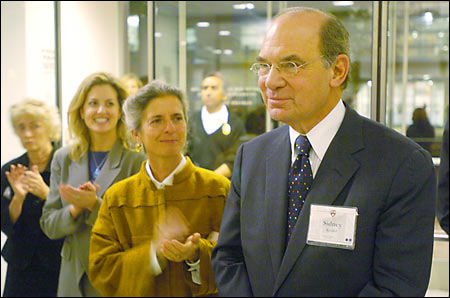CGIS new home for researchers
Harvard completes construction of new social sciences complex

With a ceremony last Friday (Nov. 4) to mark the occasion and to honor generous contributors, Harvard University has formally completed its new Center for Government and International Studies (CGIS), a 249,000-square-foot complex that will provide a spacious and airy home for dozens of researchers affiliated with Harvard’s Department of Government and various centers devoted to international and regional studies.
“These beautiful buildings are all about crossing boundaries and forming connections,” said William C. Kirby, Edith and Benjamin Geisinger Professor of History and dean of the Faculty of Arts and Sciences (FAS). “As such, they echo and advance the work of scholars in government and international studies. Their marvelous, light-filled design, their state-of-the-art facilities, and their bringing together of scholars at every level of their education all speak to a goal of communication, and even unification, across difference. CGIS will energize teaching and scholarship at Harvard.”
Designed by Henry N. Cobb ’47, M.A.R. ’49 of Pei Cobb Freed & Partners in New York, CGIS encompasses two new mirror-image buildings on either side of Cambridge Street and several renovated wood frame houses in a complex of faculty offices, graduate student workspace, classrooms, library and computer facilities, and a sleek café and 24-hour lounge. The new building on the north side of Cambridge Street is named after Sidney R. Knafel ’52, M.B.A. ’54, who committed a generous founding gift for CGIS in 1996; the building on the south side of the street is currently known as the South Building.

The striking exteriors of the two new Pei Cobb Freed-designed buildings are distinguished by rounded contours that lend an airy feel and avoid crowding the streetscape, sweeping expanses of glass, and a distinctive terra cotta façade. The buildings’ open interiors are designed to promote both formal and informal interaction, with dramatic rounded staircases and soaring atriums linking the upper floors of the buildings. The building’s upper levels are also punctuated by informal lounges featuring colorful furniture, providing space for casual interactions among faculty and students.
Some 42 percent of the new buildings’ square footage is below grade, with several innovative design features allowing natural light into the underground areas. The South Building features a sunken garden of large rocks, trees and other vegetation alongside the building, flooding a large area of the building’s concourse with natural light. The Knafel Building includes a concourse-level winter garden drawing light from a distinctive pyramidal glass structure at street level and a large triangular skylight that lets natural light into an underground library reading room.
In addition to the Department of Government, CGIS will house the Harvard-MIT Data Center, the Harvard University Asia Center, the Fairbank Center for East Asian Research, the Edwin O. Reischauer Institute of Japanese Studies, the Korea Institute, the David Rockefeller Center for Latin American Studies, the Davis Center for Russian and Eurasian Studies, the Committee on African Studies, the Institute for Quantitative Social Science, the Center for American Political Studies, the Weatherhead Center for International Affairs, several faculty from the Department of History, and flexible space available to the FAS dean to house short-term projects. The Center for Middle Eastern Studies will reside in adjacent buildings that are also considered part of the CGIS complex.
The Knafel Building houses the H.C. Fung Library, whose collections include journals and newspapers in the fields of international politics, foreign relations, foreign policy, economics, and political science. The Fung Library also houses the collections of the Fairbank Center, Davis Center, and Documentation Center on Contemporary Japan.

Together with existing buildings at 17 Sumner Road, 34-38 Kirkland St., and 1727 Cambridge St. – an existing wood-frame structure that was significantly renovated and is now connected to the Knafel Building by a glass walkway – CGIS completes a quadrangle focused on social science research. The area between these buildings has been attractively landscaped to create a cohesive identity and easy passage.
The completion of CGIS eases overcrowding at the Littauer Center, where the departments of government and economics have been sharing space along with the Littauer Library. With this fall’s departure of the Department of Government from Littauer, the Department of Economics has been able to consolidate in one building all its faculty offices, its Undergraduate Tutorial Program, and other offices serving students for the first time in nine years.
An FAS faculty committee first convened in 1992 to consider solutions to the overcrowding in Littauer. Knafel’s gift, which he made at a crucial moment in the mid-1990s, gave significant impetus to the project. Pei Cobb Freed was retained as the project’s architect in 1998, and the firm’s original design evolved significantly over the following two years in response to community concerns. As part of this outreach and consultation, the height and footprint of the two Pei Cobb Freed buildings were reduced, the buildings’ shape was changed from squared to rounded to create a softer profile, and the structures were set back from the street and granted a more inviting street presence.
CGIS construction began in July 2002. In preparation for the construction, Harvard established a mitigation program to ease the impact of construction activities upon its neighbors. Now more than three years in operation, the same mitigation program has been applied to several of Harvard’s other major construction projects located at the campus edge, including the Northwest Building project on Oxford Street and graduate student housing being built along Memorial Drive. In addition to posting weekly construction updates online and on information boards around the site and establishing a “hotline” phone number, CGIS project management met with a committee of mid-Cambridge neighbors to discuss mitigation plans for each new phase in the project.
As part of public way improvements related to the construction, Harvard planted dozens of new trees along six city streets near CGIS, committed to their care for five years, and improved sidewalks along approximately 3,500 linear feet of the same six streets.

Ceremony fetes CGIS supporters
The dedication and celebration of the Center for Government and International Studies (CGIS) last Friday (Nov. 4) honored Sidney R. Knafel ’52, M.B.A. ’54, who committed a generous founding gift for CGIS in 1996, as well as several other donors who provided support to the center.
“The Center for Government and International Studies extends greatly our opportunities for world-class scholarship and research at Harvard,” said President Lawrence H. Summers, saluting Knafel. “This gift reflects the deep insight of the donor and his vision for bringing the best learning to solving real-world challenges.”
In addition to Knafel’s gift to name the Knafel Building, the family of Felix H.T. Tsai funded the Tsai Auditorium in memory of Wan-lin Tsai; and two friends of Harvard, Bankee Kwan and Kin-chung Lam, both named seminar rooms as part of larger gifts to support graduate students, conferences, and scholarly exchange with Chinese and other Asian universities. Generous gifts from Laurence D. ’88 and Carolyn E. Belfer established the Laurence and Carolyn Belfer Case Study Room; the Harvard Club of the Philippines secured funding for a lounge; and Thierry G. Porté ’79, M.B.A. ’82 named the Huguette and Michel Porté Seminar Room in honor of his parents. Nancy and Richard Fisher ’71 and family directed a generous gift toward a café in the Knafel Building called Fisher Family Commons.
The ceremony began with a salute to those whose generosity made the Center possible, which was delivered by William C. Kirby, dean of the Faculty of Arts and Sciences and Edith and Benjamin Geisinger Professor of History. A forum on the challenges of democracy worldwide followed, which was moderated by Jorge I. Domínguez, Clarence Dillon Professor of International Affairs and director of the Weatherhead Center for International Affairs. Finally, the afternoon program culminated with the dedication of the Knafel Building and a reception in the Fisher Family Commons with remarks by David M. Cutler, dean for the Social Sciences in the Faculty of Arts and Sciences and Otto Eckstein Professor of Applied Economics.




